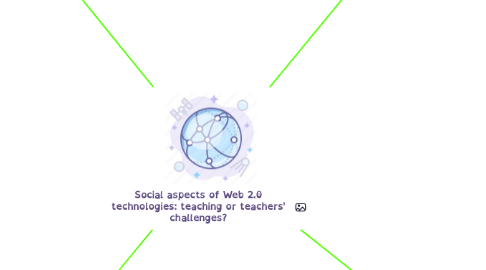
1. Role of the student
1.1. Acquire:
1.1.1. status of digital content generator.
1.1.1.1. produce
1.1.1.2. distribute
1.1.1.3. share
1.2. Be able to:
1.2.1. debate in an organized and coherent manner.
1.2.1.1. To receive opinions from others
1.2.2. build a :
1.2.2.1. Personal Learning Enviroment (PLE)
1.2.2.2. Personal Learning Network (PLN)
1.2.3. understand the specialized vocabulary
1.2.4. face social issues
1.2.4.1. at school
1.2.4.2. in their future workplace
1.2.5. trascend the concept of social media users
1.2.6. be receptive to the world around
1.2.6.1. participating in fora
1.2.6.2. radio or tv shows
1.3. Develop:
1.3.1. oral or written communication skills
1.3.2. analitytical and synthetic thinking skills
1.3.3. team work skills
1.3.4. sense of discovery and curiosity
1.3.5. positive feeling of responsability
1.3.5.1. take risks
1.3.5.2. to feel free
1.3.6. their own opinions
1.3.6.1. contradicting the course coordinator
2. Role of teaching
2.1. Learning from events
2.1.1. experiencies
2.1.2. lectures
2.1.3. conferences
2.2. Collaborative learning by doing
2.2.1. cooperation
2.2.2. team work
2.2.3. Peer review
2.2.4. media interaction
2.3. Peer - learning
2.3.1. Individual work
2.3.1.1. Peer observation
2.3.1.2. Peer feedback
2.4. Show me projects
2.4.1. individual project
2.4.1.1. doing and experimenting
2.4.1.2. students' abilities and values
2.4.1.3. video, podcast, essay
2.4.2. team project
2.4.2.1. collaborative work
2.4.2.2. online interaction
2.4.2.2.1. Google docs
2.4.2.2.2. WallWisher
2.4.3. continous project
2.4.3.1. over the time
2.4.3.2. portafolios
2.4.3.3. mindmaps
2.4.3.4. essays
2.4.3.5. recording: videos, audios.
2.5. Step by step
2.5.1. Communication and collaboration methods
2.5.2. From simple to complex digital plataforms
2.5.3. Different types of platforms
2.6. Life experiences
2.6.1. personal experiences
2.6.2. others' experiences
2.6.3. awareness of using Web 2.0
3. Role of the teacher
3.1. Acquire ability to
3.1.1. employ didactic methodologies
3.1.2. organize activities
3.1.3. bring experiencies
3.2. Meet students' expectations
3.2.1. adequate didactic behavior
3.2.2. proper communication skills
3.2.3. professional ethics
3.2.4. teach learning problem solving skills
3.3. Teach being
3.3.1. critical and active reader
3.3.2. avoid plagiarism
3.4. Focus on
3.4.1. interdisciplinary approach
3.4.2. students' interets
3.4.3. previuos knowledge
3.4.4. appropiate topics
3.4.4.1. interesting
3.4.4.2. familiar
3.4.4.3. exciting
3.4.5. validated and applied
3.5. Apply and use
3.5.1. Summarization and integration
3.5.1.1. practical application
3.5.1.2. experiences
3.5.1.3. discussions
3.5.1.4. feedback
3.5.2. Adequate set of materials
3.5.2.1. course notes
3.5.2.1.1. Content/ Learning Management System(C/LMS)
3.5.2.2. books on specific topics
3.5.2.2.1. safe and reliable information sources
3.5.2.3. academic journals
3.5.2.3.1. journal databases
3.5.2.3.2. newspapers
3.5.2.3.3. academic reference management software
3.5.2.4. media information
3.5.2.4.1. magazines
3.5.2.4.2. blogs
3.5.2.4.3. microblogs

